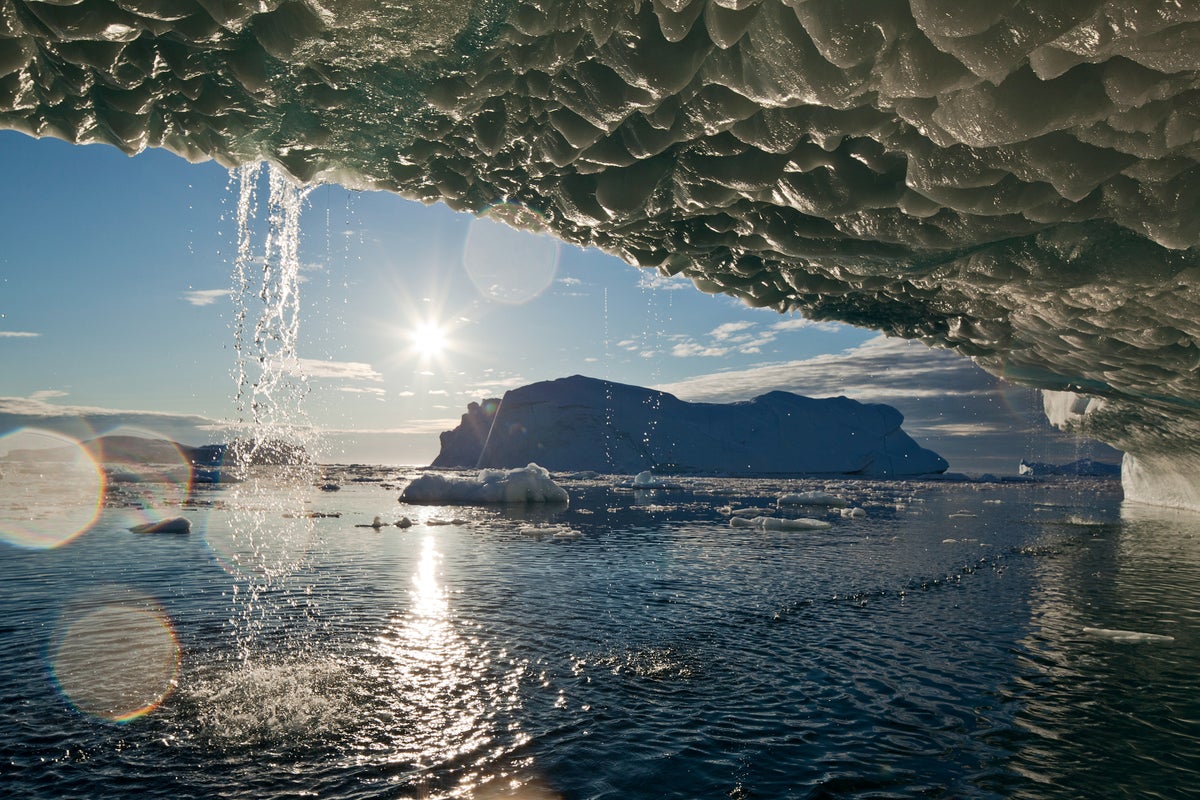World
We Must Secure Our Future in a Hotter, More Dangerous World

Flying by helicopter over the Greenland ice sheet, I am struck by its vast expanse of whiteness. But as I look closer I see that much of the ice is dotted with bright blue pools. These pools reflect a startling reality: one of the world’s largest ice cap is melting.
I’ve come to the Arctic to see the melting ice cap and the shrinking of the vast Jakobshavn glacier up close. Standing among the dust and gravel left by the retreating glacier, I am face-to-face with our climate future. That future has arrived sooner than anyone predicted: scientists in Greenland are seeing the ice sheet melt at a pace expected 40 years from now, not this summer.
What happens in the Arctic doesn’t stay in the Arctic. The melting of the Greenland ice sheet, which covers about 80 percent of the world’s largest island, could help raise global sea levels as much as eight feet by the end of the century. That’s why the slogan of the Rising Seas Institute, which organized my trip, is “Greenland’s Glaciers Change the World.”
On supporting science journalism
If you’re enjoying this article, consider supporting our award-winning journalism by subscribing. By purchasing a subscription you are helping to ensure the future of impactful stories about the discoveries and ideas shaping our world today.
As a former deputy undersecretary of defense, I can’t help but think of the implications for our nation’s security.
Imagine that it’s 2050, and seas are a foot higher than today. Cities from Miami to Mumbai are trying to adapt and rebuild their coastal infrastructure. Many have already moved to higher ground inland if they can afford to do so—more likely in Miami than Mumbai.
China and Russia still pose threats to America’s security, and our military forces are still preparing to defend Taiwan and deter further Russian aggression across Europe and elsewhere. Meanwhile, military bases, particularly navy bases on the coast, are struggling to ensure that ships, submarines and fighter jets can still perform their missions when their facilities are routinely flooded. (That is already occurring in Norfolk, Va., home to the world’s largest military complex, which includes a NATO headquarters.)
Extreme weather events such as hurricanes and typhoons occur more frequently and with more devastating impact. Then a super typhoon knocks out Taiwan’s infrastructure, preventing Taiwan and the U.S. from accurately perceiving China’s moves—not knowing whether it’s a storm-induced outage or a massive cyberattack.
America’s military outposts in the Pacific have been compromised by rising sea levels, leaving some bases incapable of performing their missions. At the same time, Russia is taking advantage of an increasingly open Arctic to lay claim to this new shipping route and the energy and mineral riches it contains.
These scenarios, and others like them, keep America’s generals and admirals up at night. They know, as do their civilian defense planners, that defending our nation is more complicated in the era of climate change. They recognize climate as a risk that must be managed, much like a nuclear attack by a rogue power. And they know that climate change amplifies other, long-standing risks. That’s why I coined the phrase “threat multiplier,” in 2007 when working with the first group of American generals and admirals to assess the national security implications of climate change.
We knew, even then, that rising sea levels, extreme weather events, prolonged droughts, melting sea ice, collapsing permafrost and deadly heat would pose risks to America’s security. Since that time America’s military and many others around the world have come to realize that they ignore climate threats at their peril.
While we are not, as a nation, adequately prepared for the risks of climate change, the U.S. military today is leading the way. From climate-proofing bases with more resilient buildings, docks and runways, to ensuring that troops can operate in higher temperatures, the U.S. and many NATO militaries are preparing for climate risks.
At the same time, the defense sector is changing the way it uses energy—not only, or even primarily, to reduce emissions of greenhouse gases—but to improve military effectiveness. We learned the hard way in Iraq and Afghanistan that trucking fuel to the front cost soldiers’ and marines’ lives as their convoys were hit by improvised explosive devices (IEDs) planted by terrorists. Today’s technological innovations, from better batteries to renewables, power our forces at the front without long supply lines of fuel, often procured from our adversaries.
At home, military bases have launched clean energy projects, as the military, energy companies and local officials recognize opportunities to improve energy resiliency through microgrids, better batteries, advanced nuclear energy and lower-carbon technologies.
Though military clean energy and climate efforts won’t stop the Greenland ice sheet from melting, they show how we can manage climate risks for the future.
First we must follow the evidence. Defense decisions are based on science and careful risk assessment. As heat waves, flooding and wildfires become more frequent and severe, defense planners are factoring these climate realities into future strategies and plans. All of society must do the same.
Second we need to prepare today for tomorrow’s threats. From making coastal infrastructure more resilient to ensuring our troops are protected in hotter temperatures, the military knows that health and readiness go hand in hand. Civilians deserve the same foresight.
Finally, like the military, we must accelerate the transition to cleaner energy sources. In addition to slowing the pace of climate change, adopting clean energy will ensure that the U.S stays at the forefront of innovation in a world increasingly untethered to fossil fuels.
By taking a clear-eyed view of climate risks and clean energy opportunities, the military is preparing today to defend America tomorrow. If civilian society does the same, we can keep our nation safer in a hotter, more dangerous world.
This is an opinion and analysis article, and the views expressed by the author or authors are not necessarily those of Scientific American.









